Journal
of Non-lethal Combatives, Dec 2002

FM 21-20 War Department Field Manual,
Physical Training, Chapter 13. Combative Activities, Section I, Combative
Contests
Copyright © EJMAS 2002. All rights reserved.
Editor's note: Punctuation, capitalization, and spelling
are as in the original.
94. VALUE OF COMBATIVE CONTESTS. This type of activity consists
of individual and group contests of a rough and strenuous nature. The purpose
of such contests is to develop aggressiveness, initiative, and resourcefulness
in personal combat; to develop proper footwork and weight control [e.g.,
distribution, rather than obesity reduction]; and to train the men to react
violently with a maximum of energy for the purpose of overcoming an opponent.
Regardless of previously developed habits in maneuvering in such contests,
the men should be instructed to attempt to overthrow the opponent at once.
Hence, in these contests, every man is trained to give his all. Defeats
suffered in early practice will be compensated for by habits of aggressiveness
and by the quick and adaptive thinking which grow from such practice.
95. ADMINISTRATION.
-
The physical training officer, while encouraging strenuous combat, should
guard carefully against conduct which might result in injury. Combative
activities should be included in the program about two or three times a
week. Different exercises should be tried, starting with the less strenuous
and gradually progressing to the more strenuous. Preference should be given
to the exercises most favored by the men. A spirit of clean play, coupled
with an all-out effort to win, should be fostered.
-
The contests in paragraph 96 are divided into dual, and group or team,
contests. Many of the dual contests may be given in the usual open-order
formation. At first, until the procedure is understood, the exercises should
be conducted to command. Later, they should be conducted informally. Group
or team activities are conducted in such group formations as are appropriate.
-
The dual contests may be conducted in several ways. The competition should
extend beyond that of only each individual against his partner. An elimination
tournament can be arranged to determine the best performer in each contest.
Team competition can be carried on by awarding the winner of each contest
one point for his team. Both these methods will greatly increase interest
in combative contests.
-
Dual and team combatives may be conducted in a number of ways, and the
instructor should consider each of the activities to determine to which
of the following variations it lends itself:
(1) Dual competition (one man against another).
-
No boundaries.
-
Circle. One man tries either to defeat the opponent within the circle or
to eject him from the circle. If he succeeds in either, he wins.
-
Double circle. Two concentric circles are drawn, one about 20 feet in diameter
and the other about 6 feet in diameter. The contestant wins if he throws
or otherwise defeats his opponent between the two circles, or if he forces
his opponent into the smaller circle or out of the larger circle.
-
Line competition. The contestant wins if he pulls his opponent across a
line, on either side of which they start.
-
Zone competition. The contestant tries to eject his opponent from the zone,
usually a strip of territory about 10 to 20 feet in width and length.
(2) Team competition.
-
Members of one team may cooperate with one another to defeat the opposing
team, "ganging up on" men of the opposing team.
-
Single-circle formation. Members of each team attempt to eject all opponents
from the circle.
-
Double-circle formation. Members of each team attempt to force opponents
out of large circle or into small circle.
-
Line formation. Members of each team attempt to pull or push opponents
over goal line.
-
Zone formation. Teams attempt to eject each other from the zone.
-
Rotating team. After the members of a team have been ranked roughly according
to ability, they then count off. For example, the members of each team
may be numbered from one to ten. First, the No. 1 man from each team engages
in combat. The loser is immediately replaced by the No. 2 man on his team.
This procedure continues, informally, until the instructor calls time or
formally until one man has conquered five opponents in succession. Obviously,
where a better opponent is opposing a poorer one, it is to the advantage
of the poorer opponent's team to have their member attempt to tire the
good opponent while attempting to defeat him. The successor to the poorer
opponent may then be able to defeat the tired man. When all of the members
of any given team have competed in turn, the No. 1 man on the team starts
again.
96. CONTESTS
a. Individual Competition.
-
Pull hands. Establish three parallel lines 10 feet apart. The men
are paired so they face each other about 3 feet apart, both equally distant
from a middle line. They grasp each other's wrists. At the starting signal,
each man attempts to pull his opponent back across his base line. Any contestant
pulled across his opponent's base line is loser. After a predetermined
time, any player pulled across the middle line is also the loser. If the
hands become separated, they are rejoined at the point of separation as
in the beginning. The contestant who first wins three bouts is the winner.
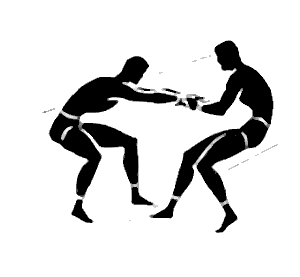
-
Hop and pull-hands. The men are matched in pairs. Each man grasps
his opponent's right hand, and hopping on his right foot, attempts to pull
his opponent over the middle line. Either contestant automatically loses
if he touches his rear foot to the ground. The contestant who first wins
three bouts is the winner. On successive bouts, they alternate hands and
feet.
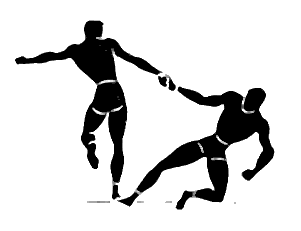
-
Back to back push. Two contestants stand back to back with elbows
locked. Each contestant has right arm inside opponent's left arm. A base
line is established 10 feet in front of each contestant. At the starting
signal, each, by pushing backward, attempts to push the other over his
(the opponent's base line. The contestants are not allowed to lift and
carry their opponent. Pushing only is permitted. A contestant pushed over
his own base line loses the bout. The contestant who first wins three bouts
is the winner.
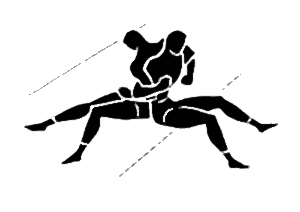
-
Back to back tug. Two contestants stand back to back with both arms
linked at the elbows. Each contestant has his right arm inside opponent's
left arm. A baseline is established 10 feet in front of each contestant.
At the starting signal, each attempts to drag the opponent over his baseline.
Lifting and carrying are permitted. Contestants must maintain original
positions with arms linked. Either contestant carried across his opponent's
baseline loses. After a predetermined time, the player carried the farthest
is also the loser. The contestant who first wins three bouts is the winner.
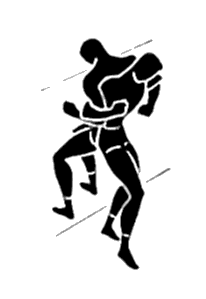
-
Back to back, arms between legs. Contestants are paired off, back
to back. A baseline is established 10 feet in front of each man. Each bends
forward and extending his right arm between his legs, grasps his opponent's
right wrist. At the starting signal, each attempts to pull his opponent
across his baseline. After a predetermined time, any player who has pulled
his opponent over his baseline or over to his side of middle line is the
winner. Repeat with left hand and then both hands. The contestant who first
wins two bouts is the winner.
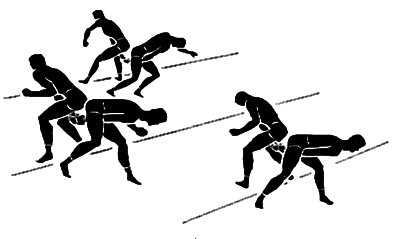
-
Knock them down (any method). At starting signal, each man attempts
to knock opponent off his feet in any manner he chooses. He may tackle,
push, pull, lift or wrestle. First man who has any part of body except
feet touching ground loses.
-
Step on toes. The men are paired off. At starting signal, each man
attempts to step on toes of his opponent. Activity continues until the
stop signal. This is a vigorous activity if continued for about a minute.
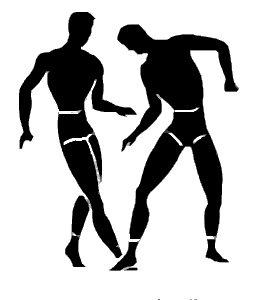
-
Arm lock wrestle. The contestants sit on the floor, back to back,
with legs spread and arms locked at the elbows. Each contestant has his
right arm inside his opponent's left arm. At the starting signal, each
endeavors to pull his opponent over to the side so that his left arm or
shoulder touches the floor. The contestant who first wins three bouts is
the winner.
-
Wrestling from Referee's Hold. The men assume what is known in wrestling
as the referee's hold. Each contestant grasps back of opponent's neck with
left hand and opponent's left elbow with right hand. In this position each
man attempts to pull or push his opponent across a line or out of a circle.
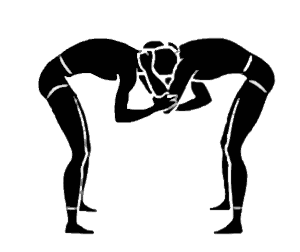
-
Bulling. The men assume the referee's hold, each grasping opponent's
neck with left hand and opponent's left elbow with right hand. Each attempts
to force his opponent to move one foot by pushing, pulling, or otherwise
manipulating him.
-
Rooster Fight. Each contestant, with arms folded across chest, hops
on right foot. He uses right shoulder and right side of chest to butt his
opponent. The object is to make his opponent lose his balance and fall,
to unfold his arms, or to touch his free foot to the ground. The contestant
who first wins three bouts is the winner.
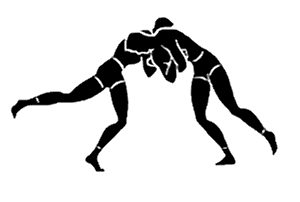
-
Rooster Fight. Each contestant grasps his left foot with right hand
from behind, and right arm with left hand. He hops on his right foot, and
by butting his opponent, or by feinting and sudden evasions, forces him
to let go of foot or arm. (The name is derived from the position of left
leg.)
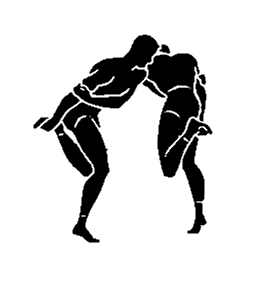
-
Stick Pull. Three parallel lines are established 10 feet apart.
Two men grasp a wand, stick, or softball bat with both hands. Starting
at the middle line, each man attempts to pull his opponent over his base
line. The contestant who first wins three bouts is the winner.
-
Pull-Stick Tug-of-War. Two men are seated on the ground with soles
of feet in contact. Each contestant grasps a stick or softball bat so that
it is directly over their feet. At the starting signal, each contestant
tries to pull his opponent from sitting position to feet.
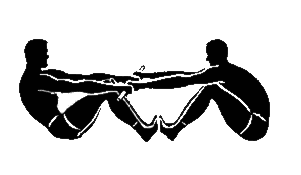
-
Stick-Twist. With right palms upward and left palms downward, both
contestants grasp a wand or softball bat. Upon the starting signal, the
contestants try to twist the stick to the left, or counter-clockwise. After
several bouts of this nature, the position of palms is changed, and the
stick is twisted to the right, or clockwise. The contestant who first wins
three bouts is the winner.
-
Stick-Wrestle. With right palms upward and left palms downward both
contestants grasp a wand or softball bat. At starting signal both wrestle
for the stick, attempting to take it away from the opponent by any means.
-
Wrist-Wrestling. Two men lie on backs, side by side, and
head to feet, in such a position that the insides of right (left) elbows
are side by side; fingers are interlocked; feet are spread and other arm
is by side. Each man tries to press his opponents' wrist down over against
his own side. The contestant who first wins three bouts is the winner.
-
Hand-Wrestling. The men stand facing each other. Right feet
are forward and braced side by side. The men grasp right hands on the first
bout (left in second bout, etc.), with little fingers interlocked. Each
attempts by pulling, pushing, making a sideward movement, or otherwise
maneuvering to force his opponent to move one or both feet from the original
position. The contestant who first wins three bouts is the winner.
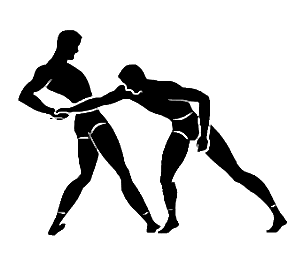
-
Harlequin Wrestling. Each men stands on his left (right) foot, holding
his opponent's right (left) hand. The object is to overbalance the opponent
or to force him to put his free foot to the ground. Pushing with shoulders
is not permitted. A modification of this contest is to hold free foot with
free hand.
-
Indian Wrestling. Two men lie on the ground, side by side, with
heads in opposite directions. They link right elbows. Upon signal of the
instructor or by mutual agreement, each man raises his right leg, with
knee approximately straight, far enough to engage heel of his opponent.
To time the contest, each man usually raises his leg three times rhythmically,
and the third time engages the opponent's heel, attempting to roll him
over backward. The right leg is used for three bouts, then the left leg
for three bouts.
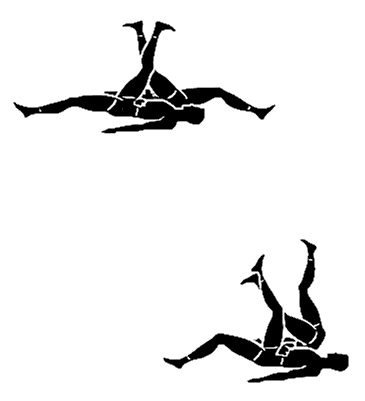
-
Wrist Bending. Opponents pair off and face each other; raise arms
forward; and with palms up, lock fingers. At the starting signal, each
man attempts to bend his opponent's wrist. The hands are brought downward
between contestants. The man winning three bouts first, is the winner.
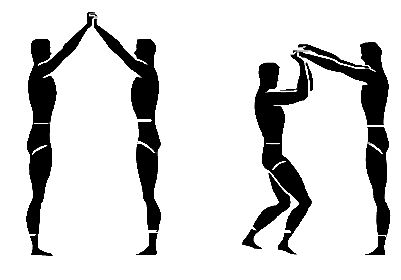
-
Wrestling to lift off feet. The contestant maneuvers to grasp the
opponent with front or rear waist-hold, and to lift him off his feet.
-
Wrestling. Each man tries to force his opponent to touch the ground
with some other part of his body than his feet.
b. Group or team competition.
-
Bull in ring. No equipment needed. Group forms in a circle holding
hands. One man, termed the "Bull", is placed in the center. If there are
more than 20 men in the ring, there are two "Bulls". The "Bull" tries to
break out by charging the ring so the clasped hands are forced apart. If
the "Bull" gets out, he immediately tags another player who becomes "Bull".
This game may be played out by two teams, each of which forms a circle.
An opposing player is the "Bull" in each circle. At the starting signal
each attempts to break out by going over, under or through. The first man
to break clear wins a point for his side. The contest continues until each
man has been a "Bull" in his opponent's circle.
-
Ring push. Players are divided into two clearly designated teams,
both of which enter a large circle. At the starting signal, players of
each team attempt to push all opponents out of circle. Players forced from
the circle are eliminated. All players must keep arms folded across the
chest throughout. The contest continues until all the members of one team
are eliminated.
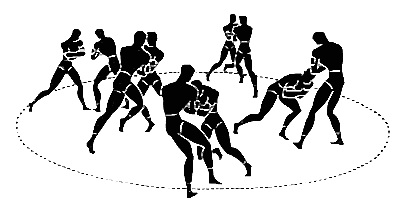
-
Line Charging. Two teams form lines facing each other about 1 foot
apart. The players of each team are 1 foot apart. A line is established
10 feet behind Team "B." At the whistle, team "A" attempts to break through
the line of team "B." Team "A" may use its hands; team "B" may not. The
players of team "B" usually assume a crouched position. After 3 to 5 seconds
(usually 3 at first, 5 seconds later), the referee blows his whistle and
counts the number of men who have broken through the opponent's line and
reached the baseline. The team which has the greatest number of contestants
reach the baseline in three attempts wins. Indoor competition may be conducted
on a string of mats.
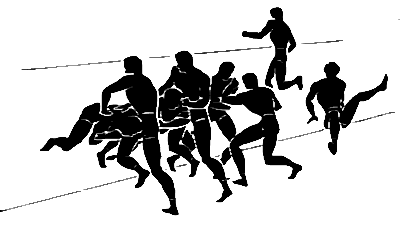
-
Sitting push out of circle. This activity is performed in the same
manner as (b) above. However, all men are seated on the ground, back to
back.
-
Island. The players are divided into two distinctively marked teams.
The teams line up on opposite sides of an area approximately 10 feet square.
At the starting signal, all players rush forward to the middle of the area
where they attempt to remain. The players attempt to throw their opponents
out of the area. If a player is forced from the island he may return if
he can before the contest is terminated. The team having the greatest number
of players on the island at the end of 2 minutes wins the game. Indoors
a mat may be used as the island.
-
Catch and pull tug-of-war. Two teams line up on either side of a
line on the ground. The men attempt to grasp an opponent's hand or wrist
and pull him across the line. Two or more of one team may gang up on one
opponent. When an individual touches the ground on the other side of the
line, he retires to the rear of his captor's territory as a prisoner. The
contest continues until all men of one team have been pulled across the
line. If any men refuse to approach closely enough to engage their opponents,
the referee declares them defeated. Such practices should be discouraged,
however. As a variation, those pulled across the line may join with their
opponents in attacking former teammates continuing until no one is left
on one side.
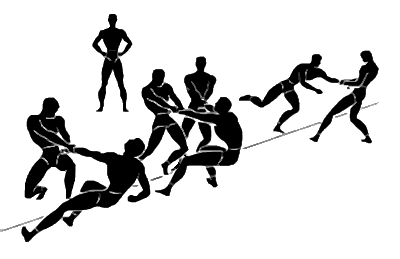
-
Horse and rider fights. Players are divided into two teams and paired
off. One player of each pair sits astride the hips of his partner and locks
his feet in front. At the starting signal, the "horses" move forward so
that the "riders" can reach each other. Each "rider" attempts to overthrow
an opponent. The "horses" are not allowed to help the "riders". The "riders"
are allowed to use all fair wrestling tactics; they are not allowed to
interfere with the "horses". The "rider" who touches the floor in any way,
either forced down from his "horse" or overthrown with his "horse" first
loses. Last team up is the winner. This contest should only be conducted
where it is not dangerous to fall.
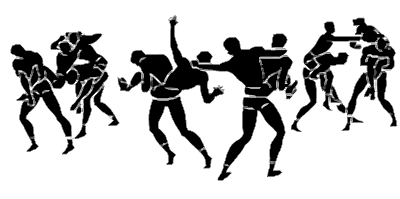
-
Goal line wrestling. This activity is performed similarly to (f)
above except that a line is drawn 15 feet behind each team and when a player
is carried or pulled across line behind his opponent's side, he is declared
"dead" and out of competition.
-
Human tug-of-war. Two teams line up in two columns facing each other.
Team members stand close together. Each man places his arms about the waists
of the men in front of him (grasping his own left wrist with his own right
hand is the strongest grip). The leading man of each team grasps his opponent
about neck and shoulders. The team breaking first or having one or men
pulled over the line separating the two teams after 30 seconds is the loser.
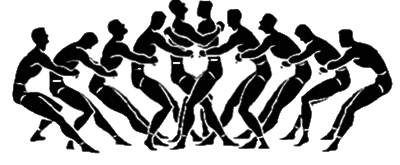
To be continued.






























